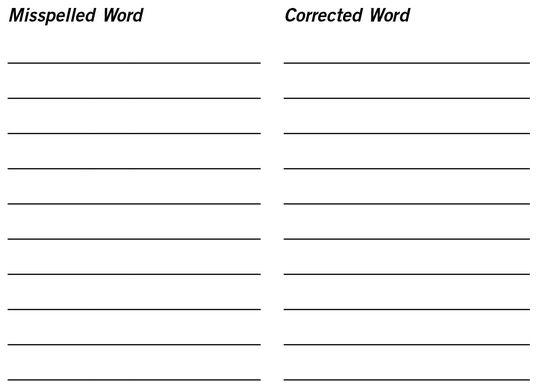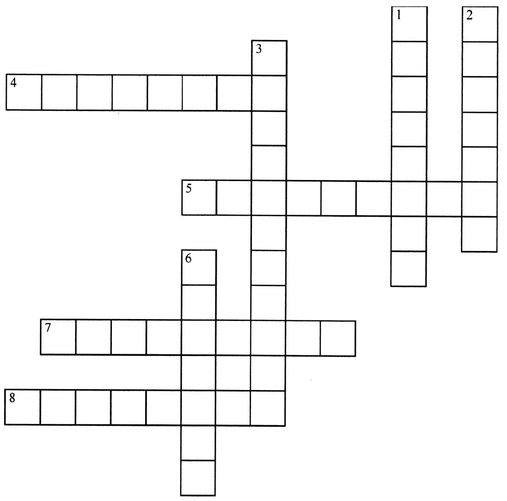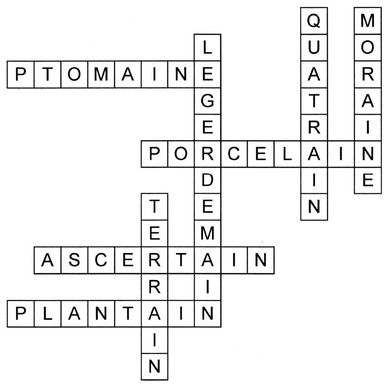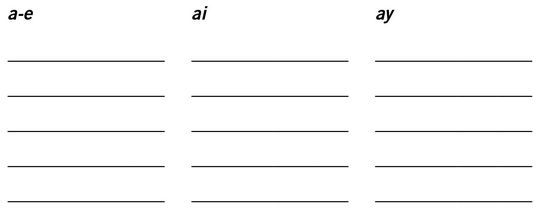Chapter 5
Vowel Movement 1: Phun with Phonics

Did you hear the one about—You heard that one? Okay, so I’ll bet that you haven’t heard this one. As you’re reading it, circle the ten misspelled words, and complete the list that follows.
An Illinois man left the fridig streets of Chicago for a vacaton in Florida. His wife was on a bussiness trip and was planning to meet him there the next day. The occassion? Their anniversary. When he reached his hotel, he decided to send his wife a quick e-mail.
Looking all accross the desk, he was unable to find the scrap of paper on which he had written her e-mail address, so he did his best to type it in from memory. Unfortunatly, he missed one letter, and his note was directed instead to an elderly preacher’s wife whose husband had died the day before. When the greiving widow checked her e-mail, she took one look at the monator, let out a peircing scream, and fell to the floor dead.
At the sound, her family rushed into the room and saw the following note on the screen:
Dearest Wife,
Just got checked in. Everything prepared for your arrival tommorrow. Your loving husband.
P.S. Sure is hot down here.

Answers
| fridig | frigid |
| vacaton | vacation |
| bussiness | business |
| occassion | occasion |
| accross | across |
| unfortunatly | unfortunately |
| greiving | grieving |
| Misspelled Word | Corrected Word |
| monator | monitor |
| peircing | piercing |
| tommorrow | tomorrow |
Phonics is the connection between sounds or groups of sounds and letters. It’s the basis for reading a language.
What Are Phonics?
We decided that approaching spelling from the way English works makes a lot of sense. After all, understanding the basics of the language can help you figure out how to spell many, many important and useful words.
The most basic kind of knowledge required for good English spelling involves phonics knowledge, the knowledge of common letter-sound relationships. For instance, you know that the sound /k/ can be represented by c, k, or ck spellings. In this chapter and several subsequent ones, we’ll have some vowel movements, thanks to phonics. (This book is too short to cover all the phonics patterns in English, so we’ll just cover some key ones that will help you become a better speller.)
Overview: Sound and Sense
Each English vowel has two sounds: one short and one long.
Short Vowel Sounds
The short vowels are the five single letter vowels, a, e, i, o, and u when they produce the sounds /a/ as in at, /e/ as in elm, /i/ as in sit, /o/ as in hop, and /u/ as in cup. We put a short curved line over a vowel to indicate it has a short sound, like this:  .
.
 .
.You only need one letter to spell a short vowel sound.
as bed ill cot up
The term “short vowel” doesn’t mean that you say them fast. No, I don’t have any idea why they’re called short, and please don’t send me e-mails with your theories. I’d far prefer chocolate and roses.
Long Vowel Sounds
The long vowel sound is the same as the name of each vowel: a, e, i, o, and u. You can hear the long sounds in ape, eat, eye, hoe, and you. We put a long line over a vowel to indicate that it has a long sound like this:  .
.
 .
.You have to add a second vowel to spell a long sound. There are two ways to do this:
 The second vowel is next to the first one in the VVC pattern: coat, paid, due.
The second vowel is next to the first one in the VVC pattern: coat, paid, due. The second vowel is separated from the first vowel by a consonant in the VCV pattern: made, tide, hide.
The second vowel is separated from the first vowel by a consonant in the VCV pattern: made, tide, hide.If the second vowel is separated from the first by two or more spaces, it doesn’t affect the first one. This is the VCCV pattern in which the first vowel remains short. Thus, doubling a consonant keeps another vowel from getting close enough to the first one to change its sound from short to long. Here are some examples:

The Schwa
Every vowel has a third sound—the schwa—in an unstressed syllable. The schwa is the most frequent vowel sound in English. It’s shown by the linguistic symbol  . For instance, the /
. For instance, the /  / is the sound made by the o in lesson.
/ is the sound made by the o in lesson.
 . For instance, the /
. For instance, the /  / is the sound made by the o in lesson.
/ is the sound made by the o in lesson.Here’s an easy saying to help you remember the way that vowels work in English: A cat says “meow.”
Making Phonics Work for You!
I’ve already reminded you that English is about as consistent as the weather in April. Nonetheless, there are some phonics rules that can make it easier for you to figure out how to spell many critical words. Here are four:
1. When a single vowel occurs in the middle of a word (or syllable), it usually has the short sound, as in the following examples: bat, hit, set, mitt, got, nut, lap, red, shot, and hut. This rule can help you figure out how to spell some words in confusing word pairs, such as rack vs. rake, lack vs. lake, tack vs. take, smock vs. smoke, and so on.
2. When a word ends with a single vowel (or syllable), it usually has a long sound. For example: go, he, ago, hyperbole.
3. When two vowels are next to each other in the same word (or syllable), the first vowel usually has a long sound and the second vowel stays silent. For example: rain, goal. This rule is traditionally taught with this clever ditty: “When two vowels go walking, the first does the talking.” Despite the cleverness of the ditty, this rule has many exceptions, such as oi (“moist” and “boil”) and the oo spelling of /u/.
4. Vowels are usually short before two consonants (VCC), as in rotten, butler, tack, tick, back, buck, bank, bark, bulk, hack, hock, hark, task, wilt, milk, malt, add, with, path, sash, and wish. Extending this further, if you hear a word with a short vowel sound followed by a k sound, there is a good chance that the k sound will be spelled by ck to give you the two consonants. In other cases, you should be able to hear the two final consonants: -sh, -lk, -rk, -sk, -th, -ch, and -nd.
Naturally, since this is English, there are a lot of weird patterns that don’t follow any rules. You just have to suck it up and memorize them. For instance:
 igh as in “high” and “sight.”
igh as in “high” and “sight.” ost as in “most” uses the long sound but “lost” and “cost” don’t.
ost as in “most” uses the long sound but “lost” and “cost” don’t. ow has two different sounds as in “low” and “cow.”
ow has two different sounds as in “low” and “cow.” ed has three different sounds as in “lifted,” “dropped,” and “moneyed.”
ed has three different sounds as in “lifted,” “dropped,” and “moneyed.” oo has two different sounds as in “book” and “loose.”
oo has two different sounds as in “book” and “loose.” -sion, -tion, and -cian are pronounced as “shun.”
-sion, -tion, and -cian are pronounced as “shun.” ed has three different sounds as in “lifted,” “walked,” and “played.”
ed has three different sounds as in “lifted,” “walked,” and “played.” oo has two different sounds as in “book” and “loose.”
oo has two different sounds as in “book” and “loose.” -sion, -tion, and -cian are pronounced as “shun.”
-sion, -tion, and -cian are pronounced as “shun.” ough has at least seven different sounds, including “bough,” “cough,” “tough,” “thought,” and “through.”
ough has at least seven different sounds, including “bough,” “cough,” “tough,” “thought,” and “through.”Party Time
Underline the incorrectly spelled word in each pair and correct it. Use the phonics guidelines that you just learned.
| 1. | aborigine | awt | _____ |
| 2. | asterik | through | _____ |
| 3. | catastroph | sesame | _____ |
| 4. | whisc | alibi | _____ |
| 5. | anemone | hindsite | _____ |
| 6. | obelick | raffle | _____ |
| 7. | shanghai | adobee | _____ |
| 8. | gibberiss | alkali | _____ |
| 9. | knich | baffle | _____ |
| 10. | calliope | squich | _____ |
| 11. | al fresco | tuff | _____ |
| 12. | sawt | buffalo | _____ |
| 13. | archipelagoe | impresario | _____ |
| 14. | couff | children | _____ |
| 15. | patricain | loose | _____ |
Answers: (1) ought; (2) asterisk; (3) catastrophe; (4) whisk; (5) hindsight; (6) obelisk; (7) abobe; (8) gibberish; (9) knish; (10) squish; (11) tough; (12) sought; (13) archipelago; (14) cough; (15) patrician.
There are so many words that don’t follow these rules that we even have a name for them: “sight words.” They include the, were, who, you, and are—and many more. These are small words, but mighty ones, well worth spelling correctly. Many people confuse where, wear, and were, for instance. Not you!
Now, let’s look a little more closely at /a/. Such a sweet little letter, and it does come first in the alphabet.
Patterns for Spelling /a/
The Long /a/ Sound
The long /a/ can be spelled the following ways:
| a-e | ai | ay |
|---|---|---|
| cellophane | rainbow | yesterday |
| counterpane | available | gray |
| celibate | praise | away |
Long /a/ This a Way
Complete the following crossword puzzle to practice spelling words with the long / / spelled /ai/. This puzzle uses eight words. Choose from the following twelve words.
/ spelled /ai/. This puzzle uses eight words. Choose from the following twelve words.
 / spelled /ai/. This puzzle uses eight words. Choose from the following twelve words.
/ spelled /ai/. This puzzle uses eight words. Choose from the following twelve words.ascertain
grain
porcelain
brain
legerdemain
ptomaine
chain
moraine
quatrain
drain
plantain
terrain
grain
porcelain
brain
legerdemain
ptomaine
chain
moraine
quatrain
drain
plantain
terrain

| ACROSS | DOWN | ||
|---|---|---|---|
| 4 | food poisoning | 1 | poetic term |
| 5 | china | 2 | a ridge, mound, or irregular mass of unstratified glacial drift, chiefly boulders, gravel, sand, and clay. |
| 7 | to figure out | ||
| 8 | banana-like vegetable | ||
| 3 | trickery, deception, sleight-of- hand | ||
| 6 | land | ||
Answers

/A/ Sort
Sort these words according to their spelling pattern for the long /a/. Write each word in the correct column.
Wednesday
throughway
desolate
disgraceful
entertainment
abstain
castaway
straight
disarray
trailer
gait
laser
displacement
urbane
sashay
throughway
desolate
disgraceful
entertainment
abstain
castaway
straight
disarray
trailer
gait
laser
displacement
urbane
sashay

Answers
displacement
urbane
laser
disgraceful
desolate
entertainment
trailer
straight
gait
abstain
disarray
sashay
throughway
castaway
Wednesday
urbane
laser
disgraceful
desolate
entertainment
trailer
straight
gait
abstain
disarray
sashay
throughway
castaway
Wednesday
Many words have entered English from French. The words that end in é have the long / / sound. For example: résumé, canapé, consommé, exposé, Salomé, café au lait, and pâpier-maché.
/ sound. For example: résumé, canapé, consommé, exposé, Salomé, café au lait, and pâpier-maché.
 / sound. For example: résumé, canapé, consommé, exposé, Salomé, café au lait, and pâpier-maché.
/ sound. For example: résumé, canapé, consommé, exposé, Salomé, café au lait, and pâpier-maché.The /ä/ sound is spelled ar as in star. The /ãr/ sound is spelled are as in dare and air as in pair.